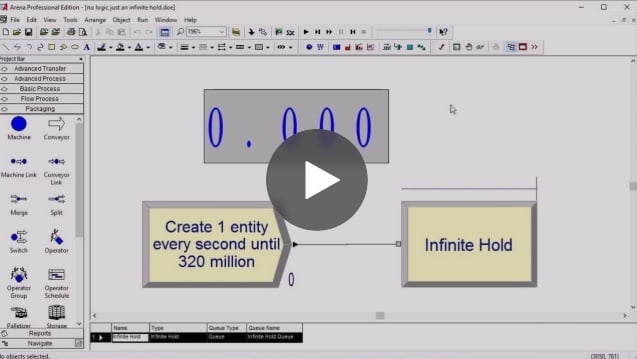Simulation allows us to understand our day to day operations and make improvements based on changes both internal and external. During a pandemic, it is more critical than ever to utilize this tool to avoid extra costs and effectively changeover. We’re seeing many different organizations tackle large changes through the power from Arena Simulation such as machine retooling, social distancing requirements, and of course, health care needs.
Topics: Manufacturing, Tips & Tricks, Project Management, Healthcare
While simulation tools have improved over time, most of these improvements have been in regards to simplifying technical hurdles, like importing data or making the user interface easier to understand. The complexity of how to break down a complicated, real-world process into concrete steps that can be modeled in a simulation language continues to be the most difficult part of using any package.
Topics: Manufacturing, Tips & Tricks, Consultant's Corner
Sometimes, a high speed packaging line must handle products that need to be stabilized during movement because of their size, shape, or spill potential. When this situation occurs, a common solution is to place the product into a puck, or carrier, during conveyance through the line operations. However, this can present a challenge to the modeler in exactly how to represent the introduction of empty pucks to the line, marrying the product with the puck, and de-pucking the product when complete. The following example discusses how to use pucks in a 1:1 relationship to product on a line.
Topics: Tips & Tricks, Packaging
The Direct Read feature has been Arena for a few years now but the capability has been expanded to more Arena elements, making it easier to import data directly into Arena for ease of use in analyzing data. For those of you who haven’t used the Direct Read functionality within Arena, it is definitely a feature worth taking a look at. Direct Read allows you to link elements in Arena with data sources so that Arena will read in the values for those elements from the data source. This means that you can create an Excel file and have data defined for your model in a workbook that you will link via Named Ranges to Recordsets in Arena.
Topics: Features, Tips & Tricks
Complex, expensive vehicles – such as airplanes or trucks – often contain a number of parts that will fail over the lifetime of the item. Approaching the modeling of this usage and failure tracking can be a tricky prospect. One solution is to use the entity’s attributes to model each part. Attributes can even be arrayed to contain additional information about the individual part, such as the installation date, number of trips made or miles logged, part number, and a unique identification code. But since every entity has a copy of every attribute, what happens when different vehicles have different part requirements? The number of attributes needed to manage this level of complexity can quickly become overwhelming and cumbersome.
Topics: Tips & Tricks
Worldwide, the average human is 5’6” (167cm) tall. This is a true fact – I know because I found it on the internet. However, is it a useful fact? Assume for a moment that you are a manufacturer of blue jeans. Would you take this average height value and then size all of your equipment so that it can only make jeans for individuals who are exactly this height? Now imagine your business was more narrowly focused in terms of your potential customer pool, e.g. men living in the United States. If you’re aiming for a smaller group, would it make any more sense to buy equipment that only makes one length of jeans? Or should you take the range of potential heights into account when designing your factory?
Topics: Tips & Tricks, Consultant's Corner
Data driven models are quick to develop, yet powerful for complex processes. SimWell, our Premier Partner in Canada, has put together this four part series which will explain what Data Driven Models are, why they are important, and how to begin making your own in Arena.
Topics: Logistics, Tips & Tricks, Port & Terminal, Project Management, Supply Chain
It comes as no surprise that being organized is the key to success in project management and that means creating a functional specification. Whether you are building one model you are going to use for analysis or two or three, organization is key. A critical aspect of organization will be defining those elements that you are going to use in the model or share across models. Taking the time to define the key resources, variables, attributes and other elements will allow you to potentially create one master database to test your models, saving you time and helping to keep your analysis organized as well. Members of the Arena Consulting Team have employed this technique with great success, using one master database structure and two very different models for a client to test out potential design ideas.
Topics: Tips & Tricks, Project Management
Arena allows you to define conveyor operation as a fixed path for material movement with pre-defined entry and exit points using the modules on the Advanced Transfer panel. Each entity to be conveyed must wait for sufficient space on the conveyor in order to gain entry and start transferring. When the entity reaches the end of the conveyor, the conveyor is disengaged until the entity is removed from the conveyor or conveyed to another station.
Topics: Tips & Tricks, Packaging
The response to our release of Arena v15 is astounding. Users with 20+ years of experience have expressed their excitement to reduce modeling time by days/weeks, and new users are diving into more complex problems more quickly. What’s all the fuss about? We share 6 Things You Need to Know about Arena v15 below.
Topics: Features, Tips & Tricks













